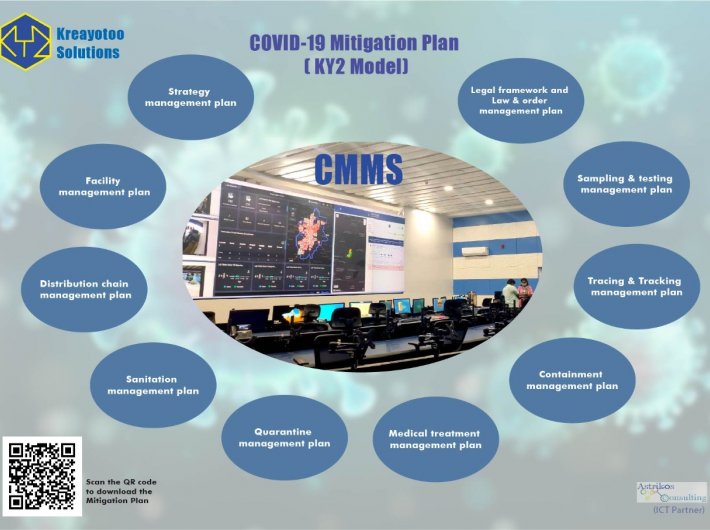As the centre and states grapple to contain Novel Coronavirus pandemic on war footing, the urban local bodies are in a rush to stem the disease. The administration is challenged for timely opportunity and implementation measurers. To help the municipalities adopt a systematic approach as mandated by the ministry of health and family welfare (MoHFW) in this dynamically changing situation, a Telangana based company has come out with an app containing all government protocols on a single platform. The app is a ready reference for all the municipalities to implement the ministry’s guidelines and protocol for COVID-19 which they can use as their templates and customize as per their requirements.
For the first time and app has been created that will serve as a repository for action and mitigation plans for stakeholders at the state and union government level with the responsibilities and role of all the line departments.
“COVID- 19 Mitigation and Preparedness at Municipality” is real time, user friendly and one stop software for all agencies fighting COVID-19 to access all government protocols with links to MoHFW advisories, guidelines, SOPs, strategies, notifications, orders, worksheets, roles and responsibilities of stakeholders on a daily basis, training and awareness programs among others measures since January 24, 2020, to stem the disease.
The repository provides easy links to various functions of stakeholders like corona call centres and transportation of patients, office of the DM and HO, police, designated supervisory officer, departments of sanitation, marketing, engineering and electricity, public representatives, mass media, NGOs, IT and technical wings and task force, ie, state and central authorities.
“The disease is evolving rapidly evolving and time is very crucial to stem the spread of infection and save lives. In the given scenario the urban local bodies do not have the time to go through a systematic approach and everyone in hurry to stem it is taking need based approaches. This is the time to help them with apps or programs For the first time and app has been created for action and mitigation plans for stakeholders at the state and union government level with the responsibilities and role of all the line departments,” said Dr K Prasad, director, Kreayotoo Solutions Pvt Ltd, the company which created the app.
“With the MoHFW updating its guidelines, roles and responsibilities on daily basis this app is a ready reckoner with up to date information for all stakeholders to search and quickly fetch the data holistically for their respective fields. It is inclusive of all the divisions in the municipality and provides a link between bifurcated roles and responsibilities of various stakeholders where higher officials can monitor and send feedback promptly,” added Prasad.
The software application has been created with inputs from Dr T Shashidhar, HoD, civil engineering, IIT Hyderabad, and is available on http://kreayotoo.com/Mi/mi.html. It can also be accessed on PDF format with hyperlink facility and downloaded using QR code.
Institutional mechanism and inter- sectoral coordination
At the state level to manage the clusters of COVID-19 the concerned state will activate the state crisis management committee or the state disaster management authority, as the case may. The district collector (DC) would be the nodal person for all preparedness and response activities within his jurisdiction. The DC will hold regular meetings with health functionaries, DDMA, revenue, PWD, forest, education, panchayati raj and local self-governance departments where the containment plan will be finalized and operationalized. These officials will issue directions to their ground level staff in all aspects of preparedness, control and containment in accordance with the containment plan and guidelines.
The DC would need to identify key issues (logistics, legal, technical and resources) and address them for implementing containment operations. He/she will keep ready all administrative orders for social distancing, restriction of rail, road and air transport, perimeter control and continuity of essential services. In addition, a compendium of all the administrative orders required for enforcing the non-pharmaceutical interventions would be prepared well in advance and kept ready to be executed during response phase.
The emergency medical relief (EMR) division, MoHF, will deploy the central rapid response team (RRT) to support and advice the state. The state will deploy its own state RRT and district RRT.
The area under geographic quarantine will be defined. There shall be (i) containment zone surrounded by (ii) buffer zone. Boundary for geographic quarantine will be defined based on: (a) geospatial distribution of each cluster contained within, (b) largest administrative unit containing all clusters occurring within a state (with a minimum of one district), (c) feasibility to implement strict interruption of movement of people (d) joint assessment by state and central RRTs.
Similarly, at the union government level, the group of ministers (GoM) under the chairmanship of the health minister will be the apex body to take policy decisions. The GoM will include the ministers of external affairs, civil aviation, shipping, pharmaceuticals, and home with the option of co-opting any other ministry. The health minister will have an advisory group that will advise him on way forward. The public health working group undersecretary (H) and joint monitoring group under DGHS will provide technical inputs. At the national level, the cabinet secretary, the national crisis management committee (NCMC), and the committee of secretaries (CoS) will review the situation across the country and continue to direct the concerned ministries to implement its directions.
The co-ordination with health and non-health sectors will be managed by NCMC/CoS, on issues flagged by the health ministry. The scale of arrangement within the ministry will be expanded with additional areas among the core capacities assigned to various officers. If need be, there will be an empowered group taking decisions for the core areas of work, i.e., planning co-ordination, surveillance, laboratory support, hospital preparedness, human resource, logistics and data analysis.
“Any programme will only be successful if implemented with a proper plan. In addition to following government protocols, the app also provides a 100-day scheduling plan for stakeholders with activity schedules given in templates” says Prasad, adding that with telemedicine becoming need of the day, it must be included in all smart city projects.

